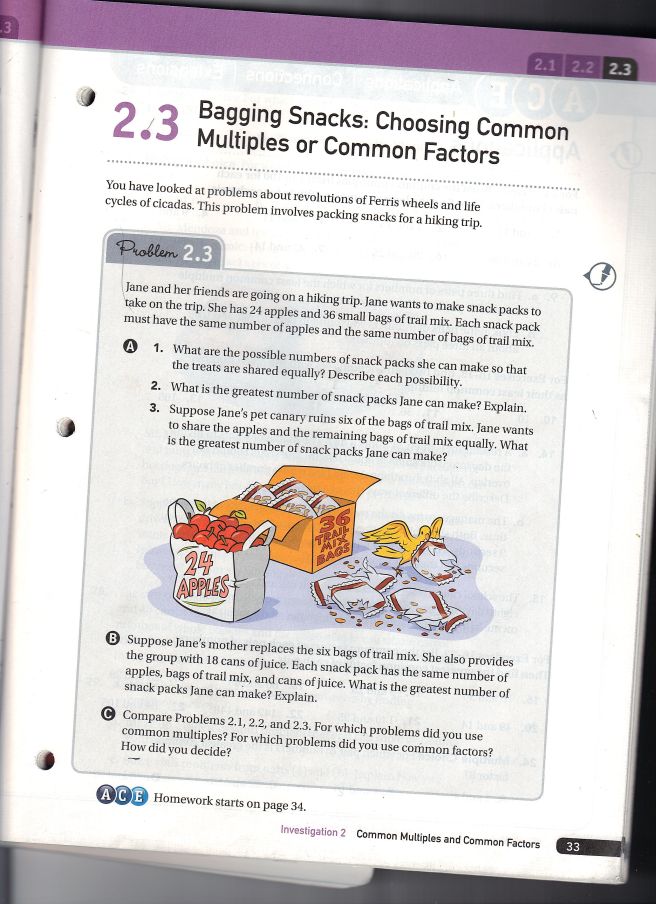We interrupt the series on religion to bring you this special bulletin on Common Core.
Please see the problem that sparked the 2.5 hour homework session and the letter I wrote to express my frustration with Common Core’s stupidity.
Dear Mr. B,
A was very concerned that she had not understood the math work for 2.3 in the Prime Time workbook.
After significant frustration, here are some of my concerns with Problem 2.3 on page 33:
1) The wording of the problem is ambiguous: “Each snack pack must have the same number of apples and the same number of bags of trail mix.”
Unfortunately, this could mean two very different things which change one’s ability to solve the answer or even to begin reasoning. This single sentence could mean:
a. Each snack bag must have the same # of apples as it does of trail mix so that the ratio of apples to trail mix must remain 1:1. EX: If you include 2 apples, you must include 2 trail mix bags.
OR
b. Each individual snack pack can vary the ratio of apples to trail mix but each snack pack must be equal to every other. EX: If you include 3 apples, you could include 6 trail mix bags.
Therefore, your ability to solve this problem depends on your interpretation of this one ambiguous sentence, making it impossible to solve as written.
2) The problem does not say whether Jane is required to use all 24 apples and all 36 bags of trail mix. It does not say whether the possibilities of combination include combinations in which some treats are not used.
And so, again, this problem is impossible to solve because if you are allowed to have left over treats, there are MANY more possibilities than the 5 which use all the treats with no remainders.
So, while it may be an awkward mouthful, this would be a better and clearer way to ask the question:
What are the possible snack pack combinations in which Jane uses all the apples and all the trail mix so that each pack has an equal number of apples and an equal number of bags of trail mix as every other snack pack?
Then one could solve the problem. And, the only way for Jane to use all the food to arrive at snack packs that are equal to each other is to combine them into one of 5 possibilities.
Hopefully, you can see my frustration with the problem. Depending on your interpretation of horribly ambiguous sentences and guesses about restrictions that are completely missing, perhaps an 11-year-old girl might get confused about how to proceed.
I realize that you do not write the word problems, nor are you responsible for the Common Core standards.
However, maybe you could help interpret the problem so that the questions of ambiguity and missing crucial information are alleviated.
Better yet, we could just say that this exercise is intended to get students to find the common factors.
So there are 5 total combinations which would allow Jane to make equal snack packs without leaving any unused snacks:
1) 12 total snack packs, consisting of 2 apples and 3 bags of trail mix
2) 6 snack packs, consisting of 4 apples and 6 bags of trail mix
3) 4 snack packs, consisting of 6 apples and 9 bags of trail mix
4) 3 snack packs, consisting of 8 apples and 12 bags of trail mix
5) 2 snack packs, consisting of 12 apples and 18 bags of trail mixI have tutored math both for fun and professionally, although my degrees are in English.
The beauty of math is its ability to foster critical thinking and logical reasoning. But more importantly, it teaches that the best way to approach problems is to simplify them. After all, we are told to simplify algebraic equations like x – 3y + 7 = 29. We use that very word to explain the process of working the problem.
Common Core math, however, gives students impossibly ambiguous and linguistically convoluted puzzles disguised as math problems and then demands linguistic acrobatics to explain their work. The creators of the Common Core have mistaken complexity for critical reasoning. Furthermore, the fact that emphasis is placed on the convoluted and nonsensical reasoning required to solve problems—and students are rewarded even when they get the answer wrong—encourages students to ignore facts.
I foresee a generation of students who try to bring in pages of Common Core approved grids—showing their work—to their banks to complain about how their math process told them that they still had $149.80 in the bank but the bank claimed they were $39.70 in the red and charged them an overdrawn fee.
“But I showed my work and my reasoning is sound!” they will shout in impotent frustration.
“But you had only $10.33 when you made your last purchase of $50.03. Simple subtraction will reveal that you were $39.70 short and you are therefore overdrawn by $39.70 and we have charged you a fee of $39.00.”
“But I used the base-ten system! See, here’s my work. Your math must be wrong. Let me see your work!” these stunningly-incapable-of-simple-math-tasks special snowflakes will whine.
And when shown the simple arithmetic of 10.33 – 50.03, they will demand to see a manager because you failed to use the base-ten system in your explanation and they cannot grasp the simplicity of simply performing basic operations.
But real critical reason approaches chaos, simplifies, and creates order. Solving math problems should be like untying a tangled skein of yarn. But if you don’t wind up with an orderly ball at the end of the work, then what was the point?
Finally, as a mother, the most important thing I’m upset about is that my daughter comes home in tears because she thinks that she is stupid!
Once I was able to see the simplicity of the problem through the jungle of words it had been disguised by, it took less than one minute to explain to A what it was she actually had to do.
The result of cumulative years of convoluted math from Florida, Idaho, and now Washington schools has taught her to overthink every problem. As a result, she is sure that she is bad at math and probably much stupider than her classmates.
Each time I explain a problem to her, she is incredulous. She cannot believe that these problems are actually stunningly simple.
To prove it, I wrote a new problem on the same pattern as this one and asked her to work it 3 hours after we had re-worked the original problem. You can see it is more complicated than the textbook example, having 4 items to consider rather than 2 or 3. Not only did she perform the requisite action correctly (finding the common factors) but she also achieved the right answer which is all the more important.
Here is the problem.
Jessica is throwing a birthday party and wants to make goodie bags to hand out to her guests. She is not certain how many people might come so she wants to make the largest number of goodie bags possible. Her mother bought a total of 40 whistles, 64 small yo-yo’s, 24 sheets of scented stickers, and 56 glow-stick necklaces. What are the possible combinations of these toys so that no toys are left over and they are divided evenly between the goodie bags? Then circle the largest number of goodie bags she can make, distributing the favors between each bag evenly with none left over so that all bags are the same. Explain your work.
Thank you for reading,
JP. S. My frustration is not with your teaching which A tells me is better than her previous teachers. Thank you for understanding.
This is not the first time I’ve had to fight her math teachers about Common Core math, nor will it be the last.
Unfortunately, there is nothing her teachers can do about this problem. It is systemic and it is federally controlled. Teachers are powerless to deviate from the lessons in Common-Core-approved texts which are created through cronyism by one of the largest education corporations, Pearson.
Stay vigilant, parents!


“Better yet, we could just say that this exercise is intended to get students to find the common factors.”
I agree with your blog entry except for this statement, and it is a HUGE problem. As badly as they phrased the questions, the point was to get students to recognize when to find common factors (as opposed to finding least common multiples, for example, which was apparently taught in the previous section of the textbook).
Someday, when you are trying to divide work up among machines in a factory, there will be no teacher standing there telling you “This is a greatest common factor problem.” You will simply have to recognize that fact.
The key is to teach students that a “dividing up equally” problem is inherently related to the greatest common factor problem, show them what problems are inherently related to the least common multiple problem, and then show them why we sometimes use both techniques (e.g. when normalizing fractions). We do NOT want to sit there and hope that they eventually figure out that “dividing up equally” problems are greatest common divisor/factor problems (the modern “discovery learning” nonsense). We want to tell them explicity. But we better not have to tell them explicitly for each assigned problem; if we do, they will need a math teacher to follow them around for the rest of their lives to remind them.